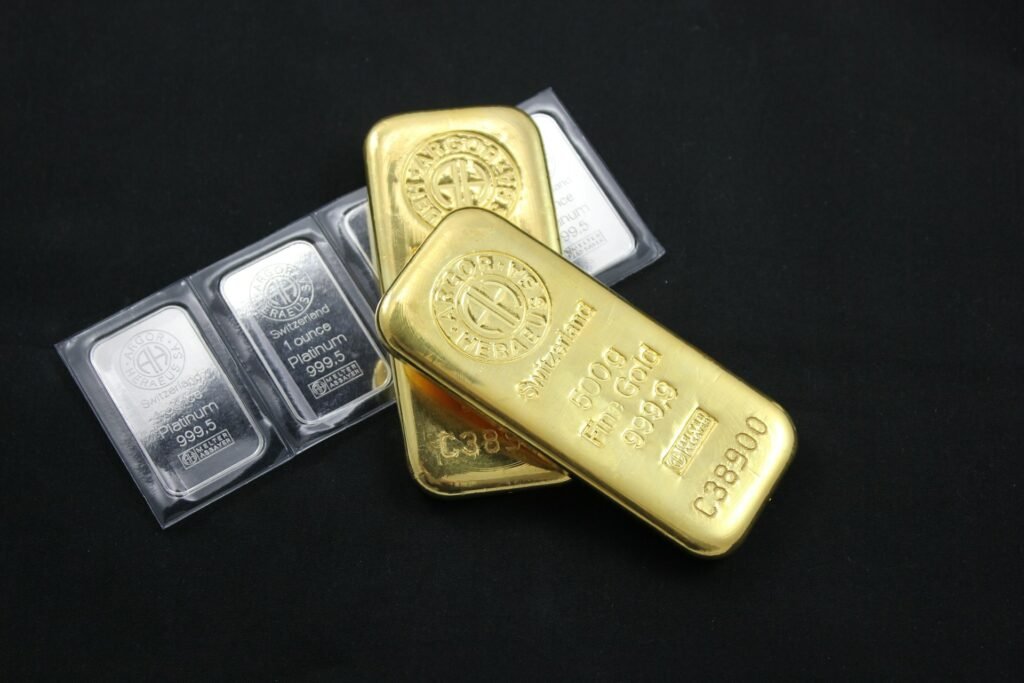Gold, Silver & Sentiment: What the Rally Reveals About Investor Behavior

Amit KC Jain
Founder and Managing Partner
Over the last several months, gold has quietly, almost methodically, reminded global markets — and Indian investors in particular — that some assets never go out of style.
As global uncertainty intensifies and the search for stability becomes more urgent, gold and silver have both emerged as key talking points once again in wealth conversations. Prices are rising, central banks are accumulating, and investors — from long-established family offices to first-generation entrepreneurs — are revisiting their views on what it means to protect wealth.
At AKCJ Ventures, we’ve seen this shift up close. The renewed fascination with precious metals tells us less about metal prices and more about how investor psychology evolves during periods of ambiguity.
This is not merely about gold’s rally or silver’s comeback. It’s about the timeless relationship between uncertainty and behavior — how wealth owners act when the horizon feels cloudy.
The Global Backdrop: Why Gold and Silver Are Back in Focus
The last two years have been a lesson in contrasts.
On one hand, equity markets have continued to climb, fueled by liquidity, innovation, and optimism about India’s long-term growth story. On the other, inflation, currency volatility, and geopolitical fragmentation have unsettled global portfolios.
Amid this duality, gold has done what it has always done best — quietly rise in value while offering psychological comfort.
A few macro factors explain the renewed momentum:
Geopolitical Tensions: The ongoing conflicts in Eastern Europe and the Middle East, coupled with strained U.S.–China relations, have reintroduced an element of systemic risk. When global order feels fragile, gold becomes the “default neutral asset.”
Central Bank Buying: Global central banks, especially in emerging markets, have been steadily increasing their gold reserves. India’s own Reserve Bank has added to its holdings — a strong signal of long-term conviction in the metal as a strategic reserve.
Currency and Inflation Dynamics: With major economies running high debt-to-GDP ratios and resorting to monetary easing, investors fear slow-burn currency depreciation. Gold serves as a store of real value — immune to monetary dilution.
Industrial Tailwinds for Silver: Silver’s dual role as a precious and industrial metal has come into sharper focus. The global shift toward clean energy, electric vehicles, and semiconductor manufacturing has made silver a critical input — giving it both monetary and industrial relevance.
Together, these trends have created a supportive environment for both metals. But more interesting than the price chart is how different investor segments are reacting.
Gold and Silver Through the Lens of Indian Wealth
In India, gold has never been a mere commodity. It’s cultural, emotional, and generational.
For centuries, it has represented safety, status, and legacy — a physical manifestation of prosperity that could be passed down through uncertain times.
But in recent years, gold’s role has been shifting from symbolic wealth to strategic allocation. Sophisticated investors now view it as part of a multi-asset, risk-managed portfolio, not just as jewelry or inheritance.
At AKCJ Ventures, our data shows that:
Five years ago, average family office gold exposure was around 3–5% of total portfolios.
Today, that figure is closer to 8–12%, and in certain conservative portfolios, it exceeds 15%.
The shift is not emotional — it’s analytical. Clients are increasingly asking how much gold should I hold? rather than should I hold gold?
Silver, meanwhile, is emerging as the “next frontier.” While it lacks gold’s legacy in Indian households, it offers something investors value in today’s environment — asymmetric opportunity.
For family offices seeking diversification beyond traditional equity and debt, silver’s industrial narrative provides both hedge and growth exposure — a rare combination.
Investor Archetypes: Three Ways Families React
Every market phase brings out distinct investor personalities. This rally in gold and silver has illuminated three particularly interesting archetypes among Indian HNIs and family offices:
The Legacy Holders
These are families who’ve held gold for generations — not because of market timing, but because it’s ingrained in their definition of wealth.
Their gold is often in physical form — bars, jewelry, coins.
Their approach is emotional, not tactical: gold represents security, not yield.
Ironically, they tend to outperform short-term traders because they don’t trade.
The Rational Allocators
This is the fastest-growing segment in India’s wealth landscape.
They treat gold as a portfolio hedge, maintaining steady allocations irrespective of price trends.
They use Sovereign Gold Bonds (SGBs), ETFs, and custodial accounts for efficiency and transparency.
They rebalance annually, not emotionally.
The Reactive Participants
These are investors drawn in by headlines and fear of missing out.
They enter late in the rally and exit too early.
Their allocation is driven by short-term sentiment rather than strategy.
In many cases, they undermine gold’s role as a stabilizer by trying to “time” it like equities.
The difference between these groups is not knowledge — it’s discipline and context.
What We’re Seeing Across Family Offices
From our vantage point advising multi-generational wealth, we’re observing a quiet recalibration in asset-allocation philosophy:
A move from speculation to structure.
Families are institutionalizing their gold exposure — moving from vaults to digital instruments, from inheritance to allocation frameworks.
Growing appetite for precious-metal ETFs and SGBs.
The liquidity, simplicity, and tax efficiency of these vehicles are winning favor.
Inclusion of silver in multi-asset strategies.
Particularly among next-gen family members who view silver through the lens of sustainability, technology, and industrial innovation.
Integration into risk models.
Gold and silver are being modeled not just as commodities but as behavioral stabilizers — assets that reduce panic and promote holding discipline when markets turn volatile.
This last point may be the most underrated benefit of all. Precious metals don’t just stabilize portfolio values; they stabilize investors themselves.
Silver’s Subplot: The Metal of the Future
For much of the past decade, silver lived in gold’s shadow. But that’s changing fast.
Silver’s industrial demand — particularly in solar panels, electric vehicles, and 5G infrastructure — is creating a long-term structural tailwind. According to global research, over 50% of silver demand now comes from industrial use, compared to around 25% two decades ago.
In practical terms, this means silver is now both:
A monetary metal — responding to inflation, interest rates, and risk sentiment.
A growth-linked asset — reflecting global shifts in energy, mobility, and manufacturing.
For family offices, that duality makes silver an intriguing complement to gold. While gold hedges against macro fear, silver participates in micro progress.
We’re seeing portfolios begin to incorporate silver via:
Silver ETFs for liquidity and simplicity.
Global funds with silver exposure within commodity baskets.
Structured products with partial downside protection linked to silver indices.
The key, as always, is sizing. Silver is volatile — but in moderation, it adds meaningful diversification.
The Role of Precious Metals in Modern Portfolios
There’s an ongoing debate about how much exposure investors should maintain to precious metals.
Our perspective, honed through years of advising both institutional and private clients, is pragmatic:
5–10% allocation suits balanced portfolios with multiple asset classes.
10–15% may be justified for conservative or legacy portfolios seeking to preserve purchasing power.
Above 15%, the marginal benefit declines — as metals are non-yielding and capital-intensive.
What matters most isn’t the number — it’s the intent.
Gold and silver are not meant to outperform equities. They’re meant to protect portfolios during stress, provide liquidity when risk assets correct, and preserve value across generations.
In other words:
“Gold doesn’t make you rich — it keeps you calm.”
That single sentence has guided more rational portfolio construction than most models ever could.
The Behavioral Edge: Calmness as Alpha
The most valuable asset in any portfolio isn’t gold, or silver, or stocks. It’s behavioral stability.
Markets punish panic. Precious metals help prevent it.
In 2020 and again in 2022, when equities corrected sharply, portfolios with a small allocation to gold fell less and recovered faster — not necessarily because of outperformance, but because clients didn’t sell.
That’s the hidden alpha of stability.
At AKCJ Ventures, we’ve learned that the real value of gold is not measured in returns, but in reduced regret. Families with thoughtful hedges sleep better and make better long-term decisions.
India’s Changing Relationship with Gold
India’s gold market is evolving faster than most realize.
Digital Gold Platforms: Younger investors are using fintech channels to buy fractional gold, democratizing access.
Sovereign Gold Bonds (SGBs): Now a mainstream instrument, offering 2.5% annual interest along with gold price exposure.
Jewelry-to-Asset Transition: Families are increasingly segregating ornamental gold from investment gold — a mental accounting shift that reflects financial maturity.
We’re moving from gold as adornment to gold as allocation.
At the same time, family offices are re-evaluating storage, insurance, and audit protocols — treating metals with the same institutional rigor as any other asset class.
That professionalization is critical. It turns emotion into strategy.
Global Context: India in the Precious-Metal Ecosystem
Globally, India remains one of the largest consumers of gold — accounting for roughly 25% of global demand.
But what’s changing is how that demand is expressed.
Urban investors prefer paper gold — ETFs, SGBs, and digital platforms.
Rural and Tier-2 households continue to favor physical gold as a form of savings and collateral.
Family offices are integrating gold into multi-asset strategies, often benchmarked alongside commodities and fixed income.
This layered demand profile gives India’s gold market extraordinary resilience. Whether prices rise or fall, the underlying affinity remains constant.
Silver, while smaller in scale, is following a similar trajectory — transitioning from industrial use to investment allocation through new financial instruments.
Strategic Perspectives for Family Offices
From our experience advising wealthy families, here are five guiding principles for managing exposure to gold and silver in today’s environment:
Define Purpose Before Allocation.
Is your precious-metal exposure a hedge, a legacy holding, or a tactical play? The structure should match the purpose.
Prioritize Efficiency.
Physical gold has emotional appeal but logistical drawbacks. For larger portfolios, SGBs or ETFs are superior — they add yield, transparency, and ease of transfer.
Integrate Into Liquidity Frameworks.
Treat metals as Tier-2 liquidity — accessible within 1–3 days but not for immediate cash flow.
Monitor Correlations, Not Headlines.
Precious metals correlate inversely with equities and currency strength. Track these metrics, not daily price moves.
Rebalance Rationally.
Set thresholds for trimming or adding exposure. Discipline beats intuition every time.
By embedding these principles, families convert sentiment into strategy — preserving emotion’s warmth while removing its volatility.
The Philosophy Behind the Metal
Every generation rediscovers gold for its own reasons.
For our grandparents, it was security.
For our parents, it was tradition.
For today’s investors, it’s diversification.
For the next generation, it may be sustainability — owning assets that align with real, tangible value.
That’s the beauty of gold and silver: their narratives evolve, but their relevance endures.
At AKCJ Ventures, we see precious metals as part of a larger conversation — about longevity, intergenerational planning, and resilience.
Our role isn’t to tell clients what to buy. It’s to help them define why they buy, and ensure every decision supports the family’s broader financial philosophy.
Final Reflections
The rise in gold and silver prices is more than a market event — it’s a mirror.
It reflects how we perceive safety, how we handle uncertainty, and how emotion and intellect coexist in financial decisions.
For India’s family offices and HNIs, the takeaway is clear: stability is the new sophistication.
The smartest portfolios of the next decade won’t just chase innovation — they’ll balance it with tradition. They’ll hold a stake in the future while keeping a foot in the familiar.
In that balance lies not only wealth, but wisdom.
At AKCJ Ventures, we continue to help families blend the best of both worlds — leveraging innovation, structure, and timeless principles to build portfolios that grow, endure, and tell a story that lasts beyond one generation.

